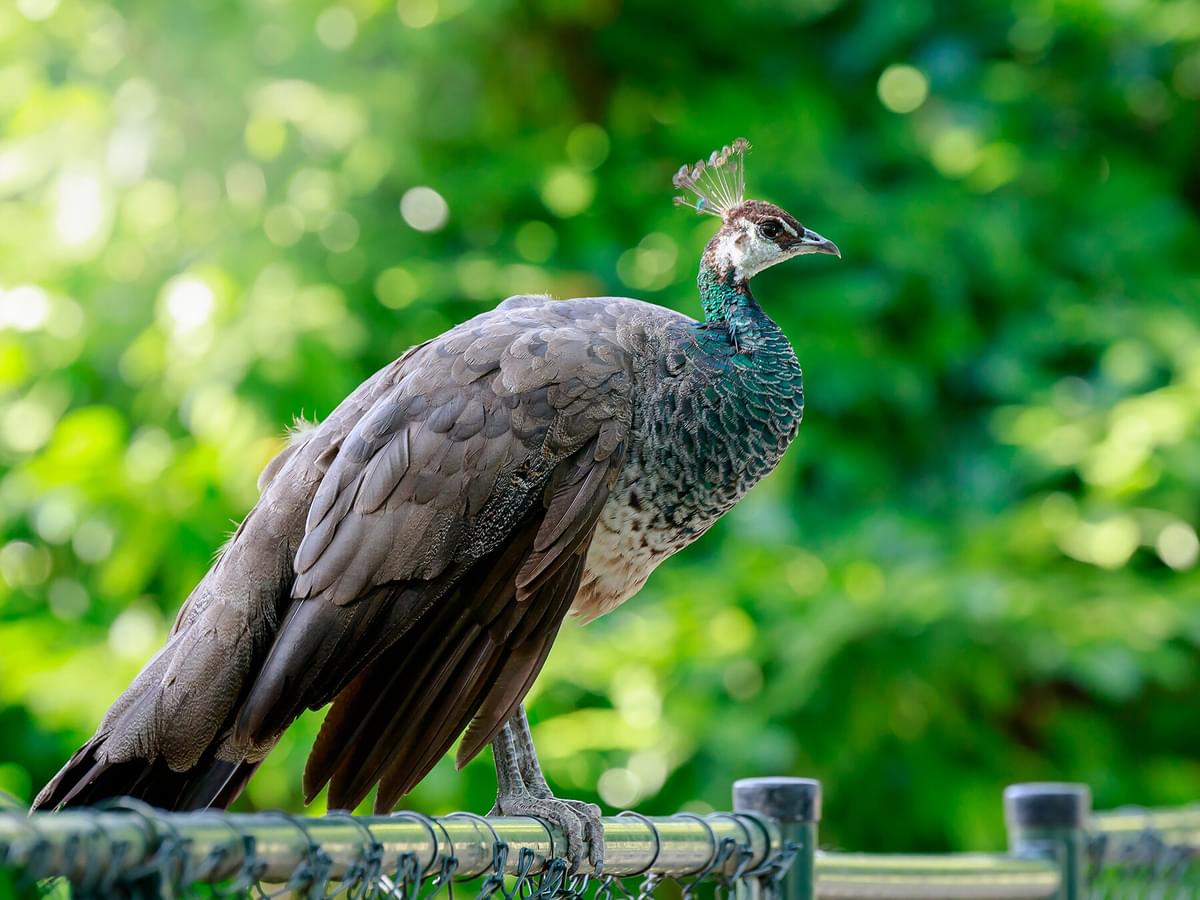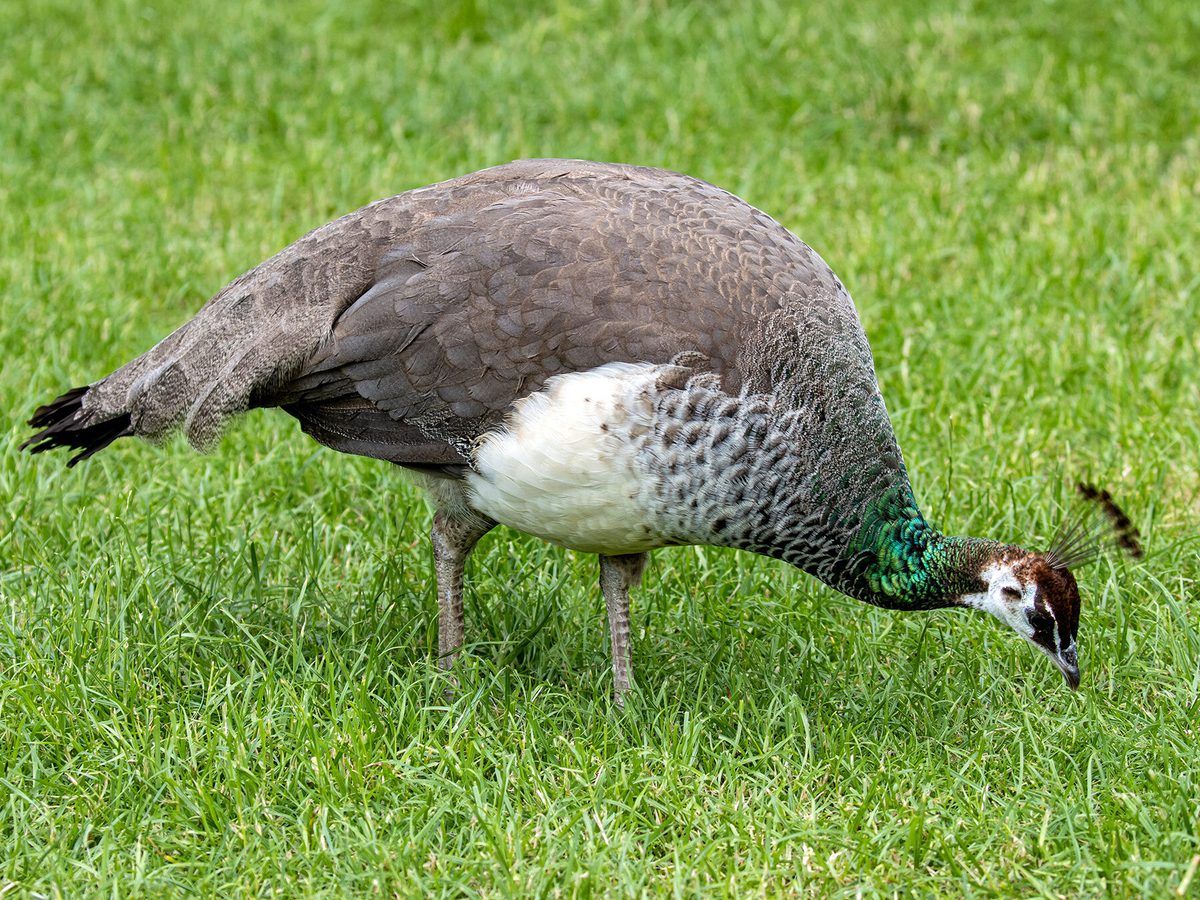Jump to Section
Female Peacocks (Male vs Female: Identification Guide)
Last updated: 9 May 2022

“Female peacocks” is an oxymoron. Peacocks are male peafowl, and peahens are female peafowl. There’s no such thing as a “male peacock”! Nevertheless, peafowl have come to be known simply as peacocks. Male peafowl - the peacocks - soak up all the attention thanks to their glorious plumage. This article is a guide to the unsung female peafowl - the peahen.
Female peafowl, aka peahens, are not nearly as lavish as their male counterparts. However, they’re still large and beautiful birds, with soft-brown chestnut plumage, a metallic-green neck, and a distinct head crest. Peacock are polygamous and mate with 3 to 5 females in one breeding season. The female peahen incubates and raises the chicks on her own, without assistance from the male.
There are just two species of peafowl in the Pavo genus of the Phasianidae family of ground-dwelling birds; the Indian peafowl and the Green peafowl.
While many people are familiar with captive peacocks and peahens, they do occur in the wild and are pretty abundant in parts of India.
Female peafowl - peahens - play a crucial role in the survival of this species. Let’s take the spotlight off peacocks for a minute and learn more about female peafowl!

Close up of a female peacock (peahen)
How can you tell if a peacock is male or female?
Peacocks are male peafowl, whereas peahens are female peafowl. They are easy to tell apart - the males are extremely colorful with an immense train of tail feathers, whereas the females are predominantly lightish brown.
Peafowl display incredible sexual dimorphism, meaning that the male looks totally different from the female. The male peacock is unmistakable, and unforgettable, with incredible multi-colored metallic plumage and an extremely long train of tail feathers, adorned with ‘eyes’.
On the other hand, the female peahen is much more modestly colored. Adult peahens have rufous-brown heads with a similar crest to the male, a green metallic neck, and dark brown breasts with glossy green shades. The underparts are whitish. The female has a much shorter tail train than the male, which is scaly or mottled with brown, light brown, and copper.
Moreover, males are larger and heavier than females. The male typically measures 100 to 115cm (39 to 45in) in body length, extending to an incredible 195 to 225cm (77 to 89in) with its tail train. The males weigh around 4 to 6kg (8.8 to 13.2lb). The female peahens measure around 95cm (37in) in total length and weigh around 2.75 to 4kg (6.1 to 8.8lb).

Female Peahen (Indian Peafowl)

Male Peacock (Indian Peafowl)
What is a peacock female called?
“Female peacock” is categorically incorrect terminology. A female peacock is called a peahen, which is a female peafowl.
A peacock is, by definition, a male, similar to how male chickens are called cockerels. The word “cock” for a male bird is derived from the Old English cocc and Old French coq, which literally mean “male bird”.
Peahens are female peafowl. The word “hen” for a female bird is also derived from Old and Medieval English (originally from the Germanic hannjo).
Are female peacocks bigger than males?
Female peafowl are not bigger than males, on the contrary. Male peacocks are exceptionally large birds, measuring over 2 to 2.3m in length (6 to 7ft) when you include their immense tail train. Contrastingly, the peahen is around 90cm to 1m in length and has a much smaller tail train.
The male also weighs more than the female; 4 to 6kg compared to around 2.75 to 4kg for the female.

Male peacock (left) and peahen (right), also referred to as female peacocks
Behavior differences
Both male and female peacocks exhibit many differences in their behavior, including some pretty interesting courtship and breeding tactics, which we'll go into more detail below.
Sexual selection and courtship
Male peafowl are polygamous and mate with a harem of 3 to 5 females. The male courtship dance is impressive; the males display by raising their tail into a huge arched fan. Next, he holds his wings half open and shakes and vibrates his long feathers. This produces quite a loud ruffling sound. The peacock then walks around and struts his plumage in front of the female.
Peafowl society is quite striking, and the differences between males and females puzzled early naturalists, including Charles Darwin. Darwin wrote to the American botanist Ada Gray “the sight of a feather in a peacock's tail, whenever I gaze at it, makes me sick!"
What puzzled Darwin was that he could see virtually no explanation for why the peacock’s plumage had evolved to become so elaborate. Many sexual dimorphisms are cosmetic or don’t affect the survivability of the species, so Darwin questioned why the peacock had evolved a very cumbersome tail that made it more susceptible to predators. However, Darwin was adept at solving such evolutionary conundrums, and peacocks prompted him to develop his theory of sexual selection.
Darwin posited that the females would continually select the males with the most elaborate plumage, causing a domino effect of evolutionary changes. Researchers today believe that this is indeed the case, though most studies find that females aren’t too bothered about choosing males with the biggest trains, most eyes, etc. So it’s almost certain that peacocks evolved for sexual selection, but it’s still a mystery how they became quite so elaborate.

A male peacock displaying to a female peahen
Raising young
Once a peacock mates with the peahen, he doesn’t hang around to assist with raising the chicks.
The female incubates the eggs for around 27 to 30 days, rarely leaving to feed or drink. During this time, the female can lose a considerable amount of weight. She’s fiercely defensive of the eggs and attacks anything that comes within about a 2m radius.
When the eggs hatch, the young peafowl - called peachicks - are able to walk within just hours. They follow their mother around, and she signals what they can eat by pecking.
The mother is extremely vigilant during this time and tries to confine her family to dense foliage. Males take almost no part in rearing the chicks. However, on exceptionally rare occasions, the male has been observed incubating the eggs, perhaps because the female died.

A female peacock (peahen) foraging for food on the ground
Calls and vocalizations
The peacock’s main call has been described as a harsh, powerful trumpet-like sound may-awe. Another of their calls sounds like a series of loud screams or shrieks ka-aan, which are repeated several times in quick succession. The male also ‘hoots’ when he approaches the female for copulation.
The female’s calls are different, consisting of a metallic kok-kok and kha-kha-kha, which the mother hen makes when agitated.
Can female peacocks raise young alone?
Female peahens raise the young alone in the wild. Once mated, the peahen will isolate herself away from males and other peahens and lays her clutch alone.
After incubating the eggs for around 30 days, the female rears the chicks for up to 9 months before they become fully independent.
While wild peahens are extremely dedicated single mothers, their motherly instincts are often very weak in captivity. When kept in captivity, some peahens take little to no interest in their chicks.

A peahen (female peacock) with her young chicks
Can a female peacock fly?
Female peafowl are able to fly, the same as males.
They can probably take off quicker thanks to their shorter, lighter tails! Peafowl are strong short-distance flyers, but usually only leave the ground to fly to a treetop perch.
Do female peacocks spread their feathers?
Female peafowl do have a train of feathers, but it’s insignificant compared to the males. In addition, they don’t possess the same fan-like tail feathers as the male.

Close up of a female peacock (Indian Peafowl Peahen)
Are female peacocks colorful?
Female peacocks do have a metallic green sheen to some of their upperparts and neck.
Despite not boasting the same extravagant plumage as the male, they are still beautiful, striking, and large birds with plenty of aesthetic qualities of their own!
On this page
- How can you tell if a peacock is male or female?
- What is a peacock female called?
- Are female peacocks bigger than males?
- Behavior differences
- Sexual selection and courtship
- Raising young
- Calls and vocalizations
- Can female peacocks raise young alone?
- Can a female peacock fly?
- Do female peacocks spread their feathers?
- Are female peacocks colorful?




